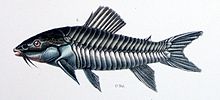- Hoplosternum
-
Hoplosternum
Temporal range: Middle Miocene - Recent
Hoplosternum littorale Scientific classification Kingdom: Animalia Phylum: Chordata Class: Actinopterygii Order: Siluriformes Family: Callichthyidae Subfamily: Callichthyinae Genus: Hoplosternum
Gill, 1858Type species Callichthys laevigatus
Valenciennes, 1834Species - Hoplosternum littorale
- Hoplosternum magdalenae
- Hoplosternum punctatum
Synonyms - Cascadura
Ellis, 1913 - Cataphractops
Fowler, 1915 - Ellisichthys
Miranda Ribeiro, 1920 - Diasternum
Franz, 2001
Hoplosternum is a small genus of freshwater catfish in the Callichthyinae subfamily of the armored catfish family, and consists of 3 species from South America, H. littorale, H. magdalenae, and H. punctatum.[1]
A fossil catfish has been identified as Hoplosternum sp. from the middle Miocene in the La Venta formation, Magdalena River basin, Colombia.[1]
Contents
Taxonomy
The type species for this genus is Hoplosternum littorale. The name Hoplosternum is derived from the Greek hoplon (weapon) and sternon (chest).[2]
Megalechis was erected to accommodate M. thoracatum, previously a species of Hoplosternum, and a related species.[3]
Distribution
H. littorale has the widest distribution of any callichthyid. It is present in all of South America east of the Andes and north of Buenos Aires, including the Orinoco, Trinidad, coastal rivers of the Guianas, Amazon River drainage, Paraguay, lower Paraná River, and coastal systems in southern Brazil. One single lot is known from the upper Paraná River and the São Francisco River drainage; it has been suggested that these occurrences may represent introduced populations. This species has also been introduced into Florida.[4]
H. magdalenae occurs west of the Andes, in the Lake Maracaibo basin in Venezuela, and in the drainages of Sinu River and Magdalena River in Colombia. Finally, H. punctatum is only found in the Atrato River basin in Colombia and in the Pacific coastal drainages of Panama, in southern Central America.[4]
Ecology
Hoplosternum is normally found in large schools on the muddy bottoms of slow-moving rivers, pools, drainage ditches, and swampy areas. In water with low oxygen content, the fish are capable of utilizing atmospheric air by taking in a gulp of air at the surface of the water and passing it back to the hind gut. The walls of the gut are lined with tiny blood vessels into which the oxygen from the air can pass, similar to the function of true lungs. The remaining gasses pass out through the anus. When there is a severe drought, these air breathers are able to traverse short stretches of land seeking better conditions. The fish is also capable of making sounds; both grunts and squeaks.
Like other callichthyines, Hoplosternum species build bubble nests. Among callichthyines, H. littorale has the most complex nest structure.[5]
In the aquarium
Spawning has been accomplished in the aquarium. Hoplosternum is a builder of bubblenests from plant parts, some bottom materials, and bubbles formed by a mouth secretion and air. The male forms a mass of bubbles about 20 cm (8 in.) in diameter and 10 cm (4 in) high. During the time of construction, the female is actively chased away or ignored. When the nest construction is complete, the male will accept the female. The eggs (up to several hundred) are deposited into the nest and the male or the pair will actively protect the nest for about four weeks until the fry come out of the nest at the size of 2.5 cm (1 in).
Cuisine
Hoplosternum is also know by the nickname "Hassa" in some South American and Asian cultures. It is normally served curried with rice.
References
- ^ a b Ferraris, Carl J., Jr. (2007). "Checklist of catfishes, recent and fossil (Osteichthyes: Siluriformes), and catalogue of siluriform primary types" (PDF). Zootaxa 1418: 1–628. http://silurus.acnatsci.org/ACSI/library/biblios/2007_Ferraris_Catfish_Checklist.pdf. Retrieved 2009-06-25.
- ^ Froese, Rainer, and Daniel Pauly, eds. (2006). Species of Hoplosternum in FishBase. March 2006 version.
- ^ Reis, Roberto E.; Le Bail, Pierre-Yves; Mol, Jan H. A (2005). Armbruster, J. W.. ed. "New Arrangement in the Synonymy of Megalechis Reis, 1997 (Siluriformes: Callichthyidae)". Copeia 2005 (3): 678–682. doi:10.1643/CI-04-353R.
- ^ a b Reis, Roberto E. (1998-05-14). "Hoplosternum Gill 1858". Tree of Life Web Project. http://www.tolweb.org/Hoplosternum/15336. Retrieved 2007-07-04.
- ^ Andrade, D. V.; Abe, A. S. (1997). "Foam nest production in the armoured catfish". Journal of Fish Biology 50 (3): 665–667. doi:10.1111/j.1095-8649.1997.tb01957.x.
- Burgess, Dr. Warren E. (1987). A Complete Introduction to Corydoras and Related Catfishes. Neptune City, NJ: T.F.H. Publications. ISBN 0-86622-264-2.
Categories:- Callichthyidae
- Fish of South America
- Edible fish
Wikimedia Foundation. 2010.
